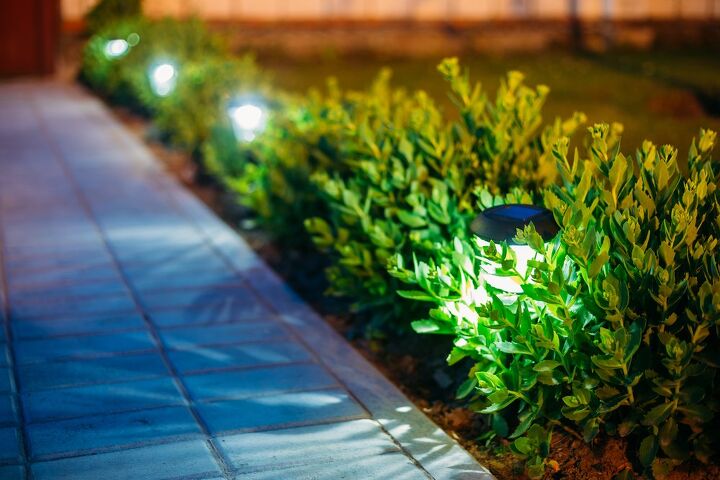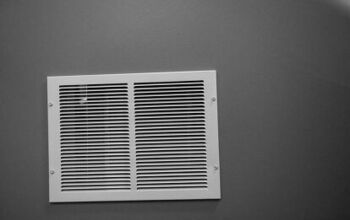How Many Lumens Do I Need For Outdoor Lighting?

Choosing the right setup for outdoor lighting can set the tone for someone’s first impression of your home. It can also set the tone for any time that you entertain friends and family, as long as you get it right. Many homeowners have asked themselves: how many lumens do I need for outdoor lighting?
You generally need 75 lumens per square foot for outdoor lighting, but only if you have a medium-large yard. Each outdoor wall light generally needs to be 50-200 lumens and each porch light needs to be 300 lumens, on average. The brightest outdoor lighting fixtures are typically floodlights which are usually 500-1,300 lumens each.
You don’t need to always follow the 75-lumens per square foot rule because that may be too bright for some homeowners. That is especially true if you have nearby neighbors because you don’t want to illuminate their yards. Follow along as we explore how many lumens you need for outdoor lighting.
Is 500 Lumens Bright Enough For Backyard?
In most cases, 500 lumens is more than bright enough for outdoor lighting in a backyard. That is enough light to illuminate a large backyard even if you have plenty of tree cover. Generally, 500 lumens is only recommended for large yards, and if you can spread it out throughout several fixtures.
For example, you could have up to 5 fixtures that are each 100 lumens. This is common practice for homeowners that have a patio and or gazebo deep into their backyard. However, 500 lumens would be too much if you have a small backyard and nearby neighbors.
Light would spill over into your neighbor’s yards on either side of your home if their houses are right beside yours. In that case, you could stick with 75-200 lumens for your backyard and it would be bright enough.
Outdoor Lighting Lumens Per Square Foot
Landscapers and designers recommend that you have 75 lumens per square foot for outdoor lighting. However, this isn’t an ironclad rule and that could be far too much for you depending on the layout of your porch, patio, or backyard. This rule mostly applies to large backyards or spaces such as porches and patios that you want to illuminate.
The average patio measures 288 square feet, but you would rarely need 21,600 lumens for such a space. The 75 lumens per square foot rule applies to large, spread-out backyards with several spaces for entertainment. This would apply to a large backyard with a patio, gazebo, and even a fire pit area.
How Many Lumens Do You Need For Outdoor Lighting?
How many lumens you need for outdoor lighting depends on the size of the yard and how many fixtures you have. You don’t necessarily want to use bulbs with the same amount of lumens for each fixture in your yard. Otherwise, you run the risk of having an overly bright backyard and running up a huge electrical bill.
It also depends on how many light fixtures you want for your outdoor space. For outdoor lighting, each fixture should typically have a 50-1,300-lumen light bulb. Start with 1 or 2 fixtures and go from there to figure out how bright you want your outdoor lighting.
How many lumens you need also depends on the type of light fixture. Common fixtures for outdoor lighting include outdoor wall lights, porch lights, and flood lights. Let’s take a look at how many lumens you need for each type of outdoor lighting fixture.
Outdoor Wall Light
Outdoor wall lights generally only need to be 50-200 lumens. This comes down to preference and what you need the light for. They don’t generally need to be too bright unless you have them along a dark path with tree cover.
Currently, LED lights are the most common outdoor wall lights because they last for up to 50,000 hours. Outdoor wall lights under 50 lumens are still viable, but they may not be bright enough if you’re trying to illuminate a path.
Porch Light
The average porch light is 300 lumens, but you can go higher or lower based on preference. Avoid porch lights that are under 200 lumens because they likely won’t be bright enough. Anything over 500 lumens is generally too bright, especially if you have an LED bulb.
Driveway
Driveway lights rarely need to exceed 200 lumens, but many homeowners choose lower bulbs. Ideally, you don’t need a bulb brighter than 100-120 lumens for your driveway. However, you should follow the 75-lumens per square foot rule if you have a particularly long driveway.
Floodlight
The average homeowner uses 1,000-lumen floodlights, but you can go as high as 1,300 lumens. It’s common to use 2 floodlights that are each 700 lumens if you have a long driveway. However, some motion-activated floodlights don’t exceed 500 lumens, and that’s fine if they are LEDs.
Many homeowners with large houses place multiple floodlights throughout the property that are each 700-1,000 lumens.
Garage
You need anywhere between 2,000 and 8,000 lumens for garage lights. For example, a 2-3 car garage would require over 5,000 lumens in most cases to illuminate the entire space. However, a single-car garage can easily get by with 1,000-2,000 lumens if it is uncovered.
How Many Lumens to Uplight a House?
Each fixture should be 120-180 lumens to uplight a house. Uplighting is popular because it can make your house feel much more grand and elaborate than it would look in the daylight. It can also add depth and a sense of drama to your home in the darkness
Uplighting varies based on how many stories your home has. The lights pointing up at the first level only need to be 80 lumens each. Increase the lumens with each level that you go up because it will be further from the light source, so it needs more power.
You need a 270-lumen light to uplight the 3rd floor of your home. If you have a 4-story home, you need to have at least one light that is 1,000 lumens to reach that high. Otherwise, the light will weaken as it goes up higher with each succeeding level. Most homeowners position the lights and stagger them so that the higher lumen lights only point at the higher levels so that it’s even.
Is 500 Lumens Bright Enough For a Porch Light?
Typically, 500 lumens is too bright for a porch light unless you have a large porch. You rarely need to exceed 300 lumens unless your porch is big and you spread it among a few bulbs. Otherwise, the light will likely extend into your yard or even make it too bright within your home.
The purpose of a porch light is to make it easier to enter your home or help others find your house. While a light that is too bright can help with both of those things, it can also be unappealing and even annoy your neighbors or guests.
How Bright Is 500 Lumens in Watts?
A 500-lumen incandescent lightbulb is 60 watts. The type of bulb affects how many watts it is relative to the lumens. For example, an LED bulb that is 500 lumens only comes out to be 6 watts on average.
While they are less common nowadays, a 500-lumen halogen bulb is 50 watts. The low wattage of LED bulbs despite the bright output has a lot to do with why they have become the standard. You get more brightness and longevity with 500-lumen LED bulbs without harming the environment.
How Many Lumens Is Considered Bright?
Anywhere between 80 and 120 lumens is considered bright. However, brightness is relative to the size of your yard and how much tree cover you have. For example, 120 lumens may not seem very bright if your yard is surrounded by trees that block natural moonlight.
That is why it’s better to strategically scatter lights that aren’t too bright throughout your entire yard so that no particular area is too bright. Some fixtures may exceed 500 lumens, but not all of them should. Many homeowners only need a pair of 50-200-lumen wall lights and a 300-lumen porch or patio light.
Summing It Up
The general rule of thumb is that you need 75 lumens per square foot for outdoor lighting. This primarily only applies to large backyards that have gazebos, porches, and patios. Homeowners use anywhere between 50 and 1,300 lumens for outdoor lighting depending on the size of their property.
Outdoor wall lights go up to 200 lumens each, and flood lights go up to 1,300 lumens. Porch lights are 300 lumens, on average, but they can be as bright as 500 lumens, although that is too bright in many cases. Don’t adhere to the 75-lumen per square foot rule too closely if you have nearby neighbors on each side because you don’t want to over-illuminate your yard.
Related Guides

Nick Durante is a professional writer with a primary focus on home improvement. When he is not writing about home improvement or taking on projects around the house, he likes to read and create art. He is always looking towards the newest trends in home improvement.
More by Nick Durante



























